Abstract
Enrofloxacin was given to broiler chickens, 3 groups of 6 birds each, at a dose of 5 mg/kg. Routes of administration were intravenous (i.v.), intramuscular (i.m.) and oral (p.o.) and blood samples were collected from the jugular vein for determination of serum drug levels over a 54-hour period after administration. Drug levels were determined using Bacillus subtilis spore suspension on Meuller-Hinton antibiotic medium. Intravenous administration produced drug levels which followed a bi-exponential decay according to the model C = 101e(-1.84(t)) + 1.30e(-0.06(t)). After i.m. administration, the mean Cmax observed (2.01 microg/mL) occurred at 1 h and levels were detected for up to 48 h. The mean time to maximum concentration (Tmax) for the birds occurred at 0.79 h. The model describing serum concentrations after i.m. administration was C = 1.35e(-0.48(t)) + 1.27e(-0.07(t)) - 2.06e(-2.1(t)). Serum concentrations after oral administration were lower and the mean +/- standard error of mean, of the maximum concentrations (Cmax) was 0.99 microg/mL at 2 h after administration. The mean residence times after the 3 routes of administration were not significantly different and ranged from 12.5-13.7 h. Bioavailability by the oral route was 80.1%. Dialysis of chicken plasma vs saline indicated that the protein binding was 22.7%.
Full text
PDF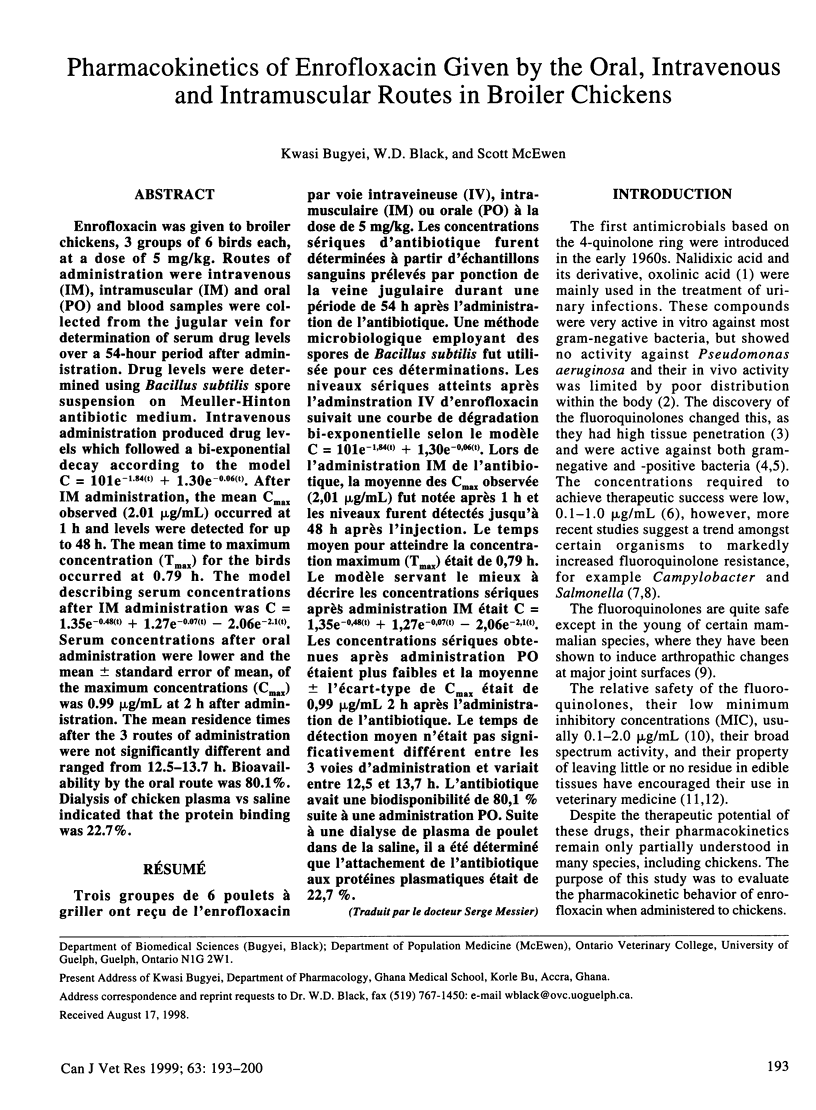
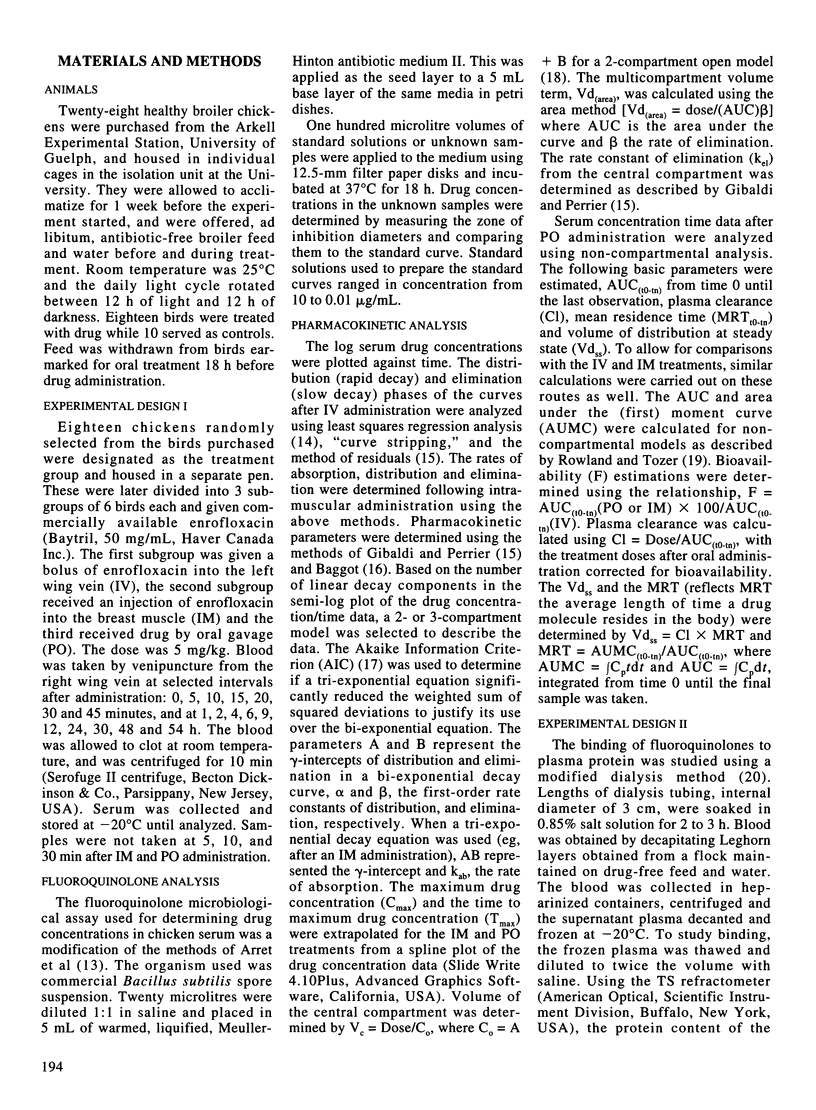
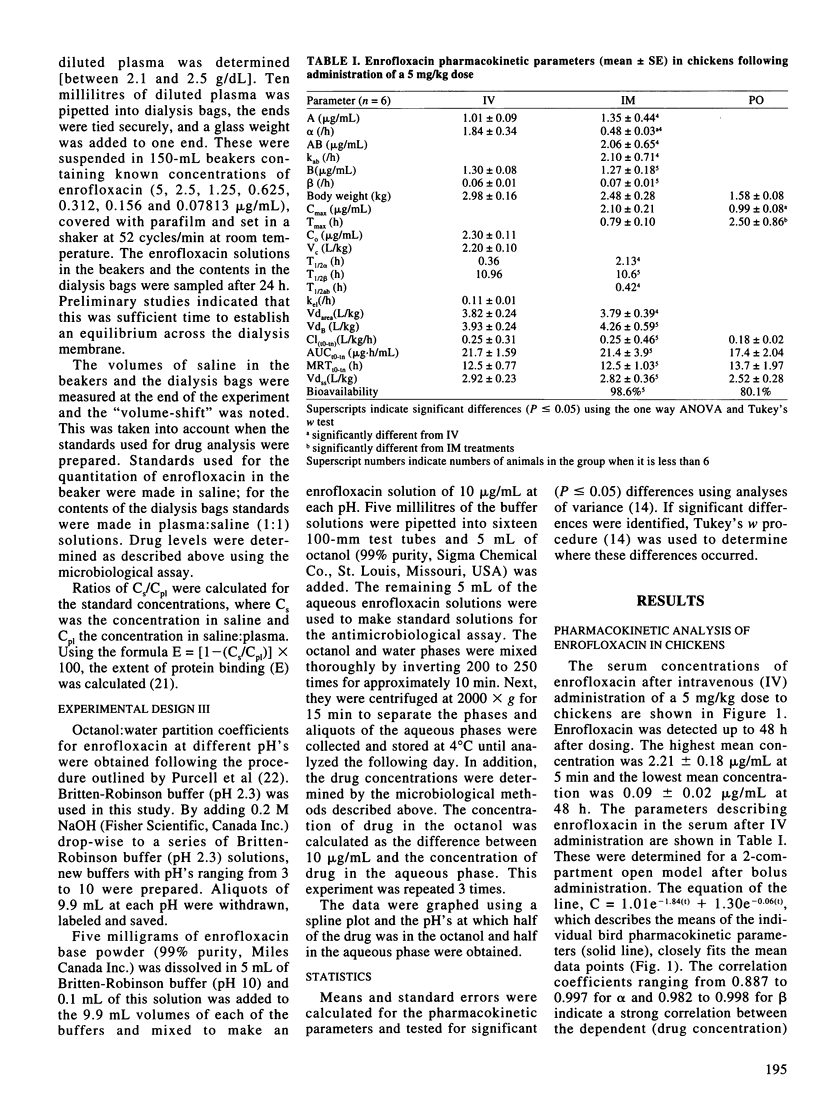
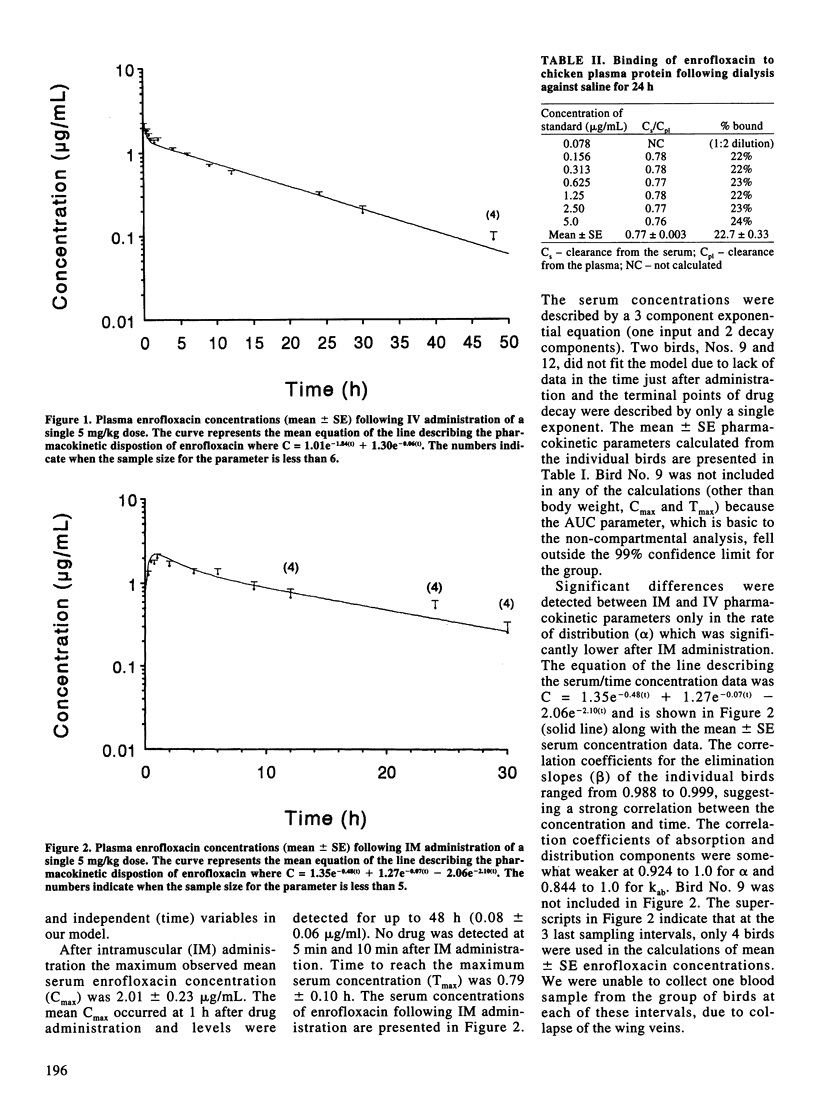
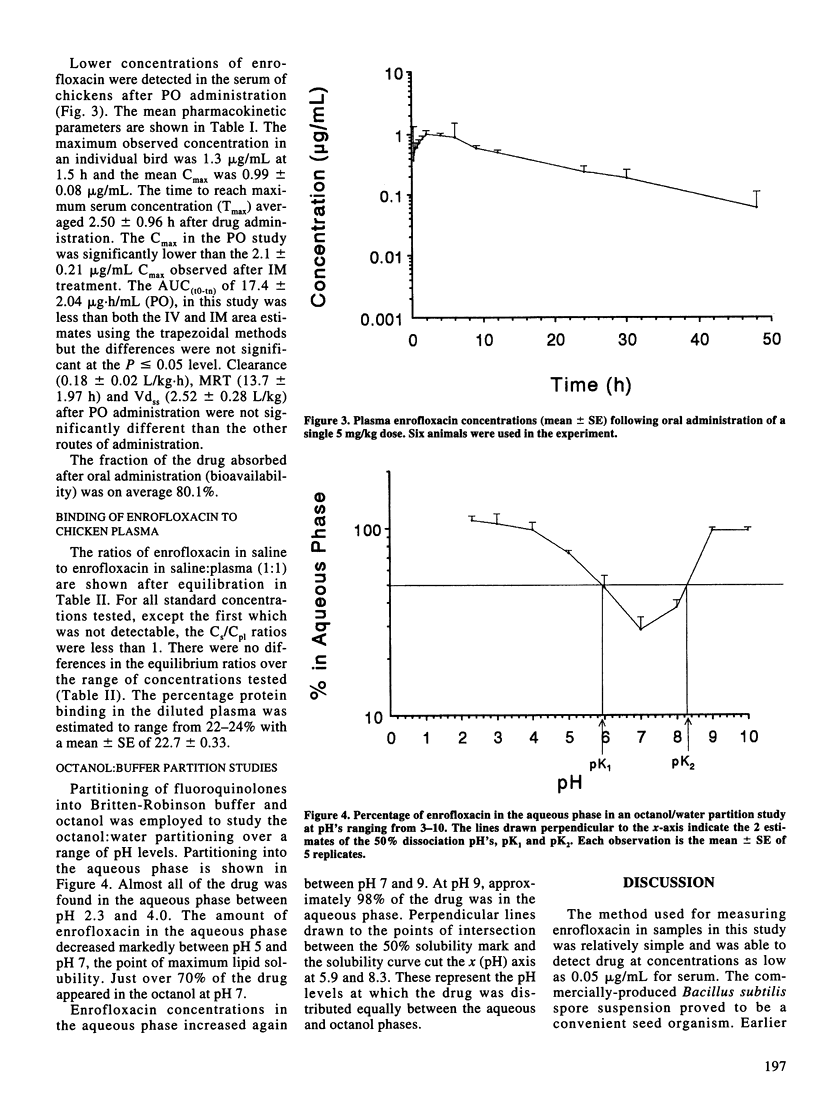
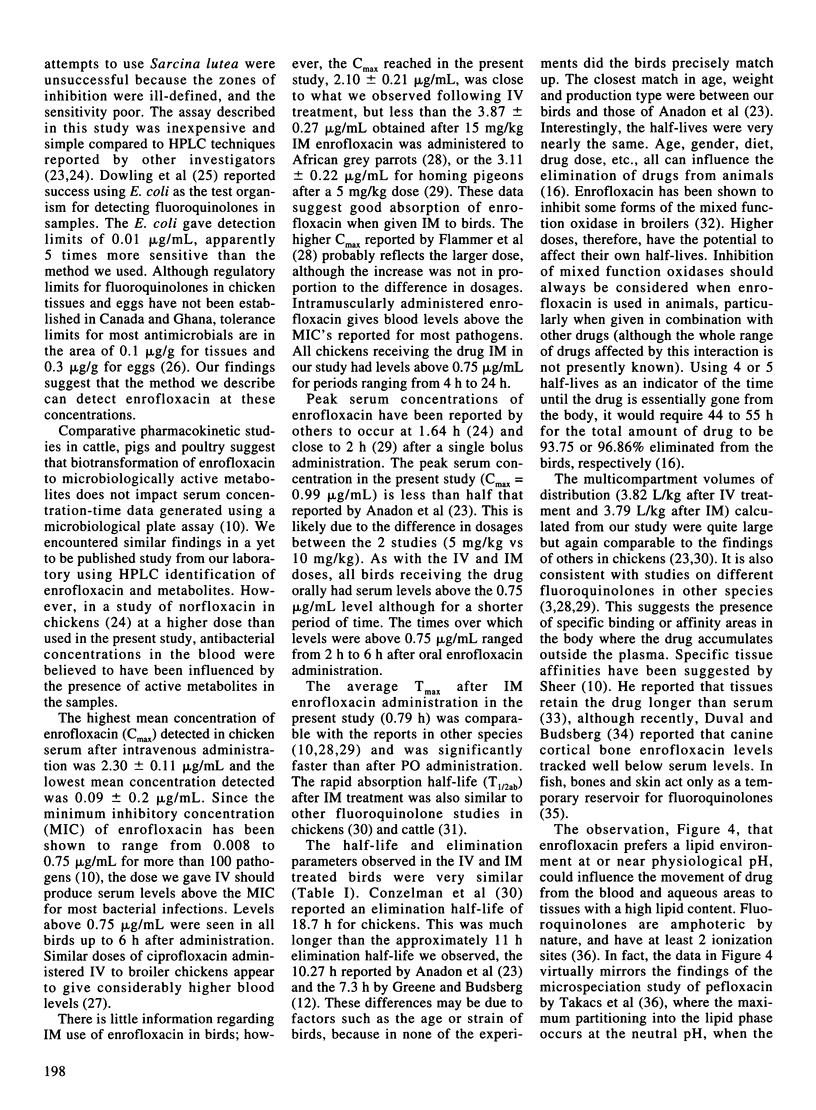
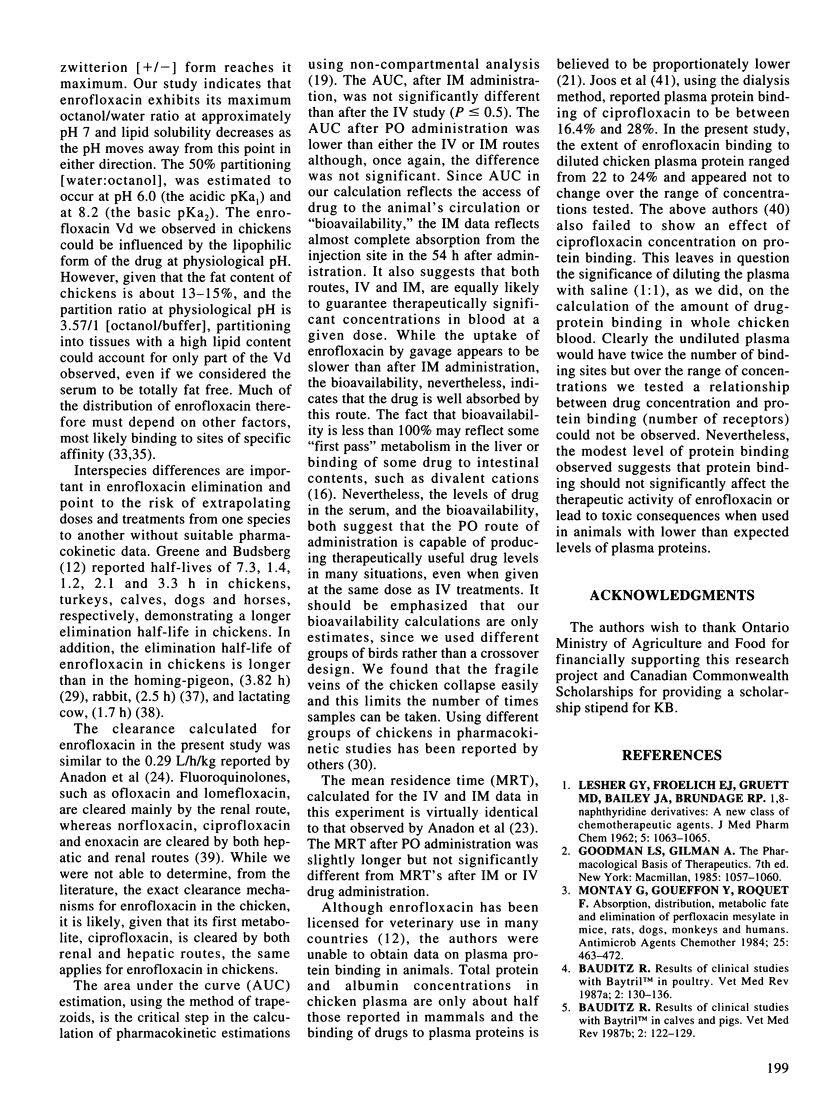
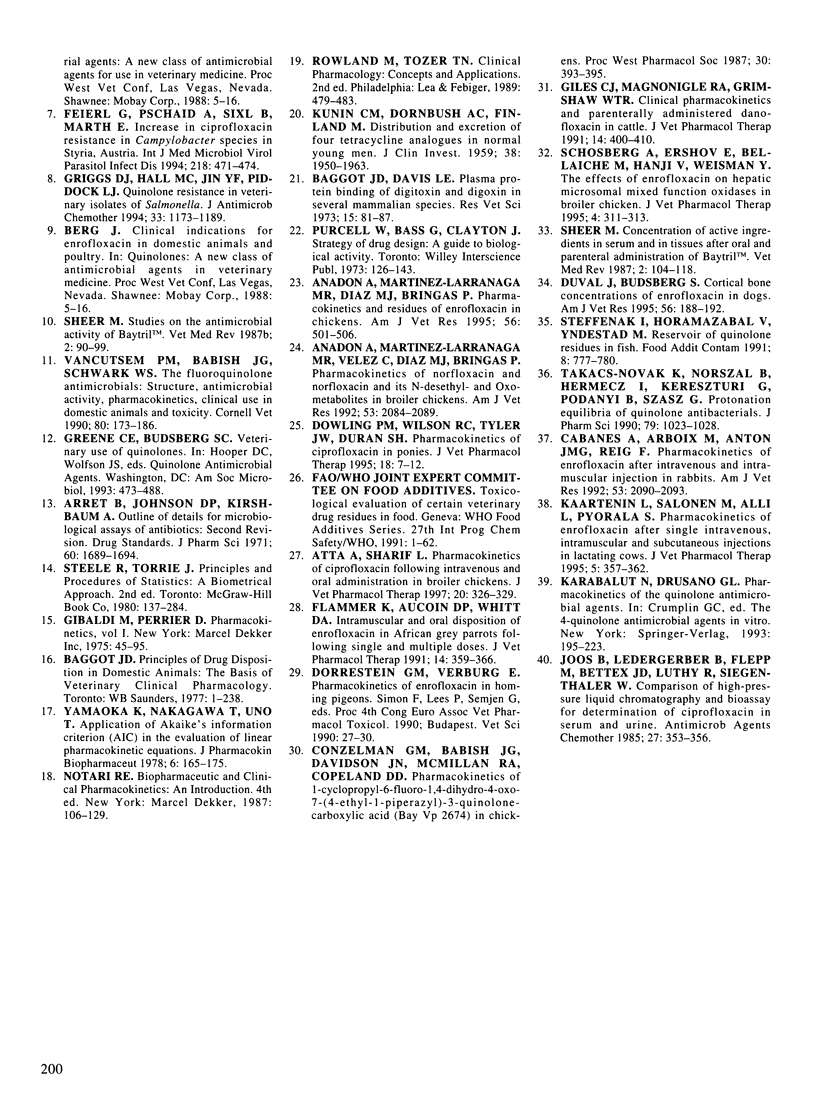
Selected References
These references are in PubMed. This may not be the complete list of references from this article.
- Anadón A., Martinez-Larrañaga M. R., Velez C., Díaz M. J., Bringas P. Pharmacokinetics of norfloxacin and its N-desethyl- and oxo-metabolites in broiler chickens. Am J Vet Res. 1992 Nov;53(11):2084–2089. [PubMed] [Google Scholar]
- Anadón A., Martínez-Larrañaga M. R., Díaz M. J., Bringas P., Martínez M. A., Fernàndez-Cruz M. L., Fernández M. C., Fernández R. Pharmacokinetics and residues of enrofloxacin in chickens. Am J Vet Res. 1995 Apr;56(4):501–506. [PubMed] [Google Scholar]
- Arret B., Johnson D. P., Kirshbaum A. Outline of details for microbiological assays of antibiotics: second revision. J Pharm Sci. 1971 Nov;60(11):1689–1694. doi: 10.1002/jps.2600601122. [DOI] [PubMed] [Google Scholar]
- Atta A. H., Sharif L. Pharmacokinetics of ciprofloxacin following intravenous and oral administration in broiler chickens. J Vet Pharmacol Ther. 1997 Aug;20(4):326–329. doi: 10.1046/j.1365-2885.1997.00065.x. [DOI] [PubMed] [Google Scholar]
- Baggot J. D., Davis L. E. Plasma protein binding of digitoxin and digoxin in several mammalian species. Res Vet Sci. 1973 Jul;15(1):81–87. [PubMed] [Google Scholar]
- Cabanes A., Arboix M., Garcia Anton J. M., Reig F. Pharmacokinetics of enrofloxacin after intravenous and intramuscular injection in rabbits. Am J Vet Res. 1992 Nov;53(11):2090–2093. [PubMed] [Google Scholar]
- Conzelman G. M., Babish J. G., Davidson J. N., McMillan R. A., Copeland D. D. Pharmacokinetics of 1-cyclopropyl-6-fluoro-1,4-dihydro-4-oxo-7-(4-ethyl-1-piperazinyl)-3-q uinoline- carboxylic acid (BAY Vp 2674) in chickens. Proc West Pharmacol Soc. 1987;30:393–395. [PubMed] [Google Scholar]
- Dowling P. M., Wilson R. C., Tyler J. W., Duran S. H. Pharmacokinetics of ciprofloxacin in ponies. J Vet Pharmacol Ther. 1995 Feb;18(1):7–12. doi: 10.1111/j.1365-2885.1995.tb00543.x. [DOI] [PubMed] [Google Scholar]
- Duval J. M., Budsberg S. C. Cortical bone concentrations of enrofloxacin in dogs. Am J Vet Res. 1995 Feb;56(2):188–192. [PubMed] [Google Scholar]
- Feierl G., Pschaid A., Sixl B., Marth E. Increase of ciprofloxacin resistance in Campylobacter species in Styria, Austria. Zentralbl Bakteriol. 1994 Nov;281(4):471–474. doi: 10.1016/s0934-8840(11)80333-6. [DOI] [PubMed] [Google Scholar]
- Flammer K., Aucoin D. P., Whitt D. A. Intramuscular and oral disposition of enrofloxacin in African grey parrots following single and multiple doses. J Vet Pharmacol Ther. 1991 Dec;14(4):359–366. doi: 10.1111/j.1365-2885.1991.tb00849.x. [DOI] [PubMed] [Google Scholar]
- Giles C. J., Magonigle R. A., Grimshaw W. T., Tanner A. C., Risk J. E., Lynch M. J., Rice J. R. Clinical pharmacokinetics of parenterally administered danofloxacin in cattle. J Vet Pharmacol Ther. 1991 Dec;14(4):400–410. doi: 10.1111/j.1365-2885.1991.tb00854.x. [DOI] [PubMed] [Google Scholar]
- Griggs D. J., Hall M. C., Jin Y. F., Piddock L. J. Quinolone resistance in veterinary isolates of Salmonella. J Antimicrob Chemother. 1994 Jun;33(6):1173–1189. doi: 10.1093/jac/33.6.1173. [DOI] [PubMed] [Google Scholar]
- Joos B., Ledergerber B., Flepp M., Bettex J. D., Lüthy R., Siegenthaler W. Comparison of high-pressure liquid chromatography and bioassay for determination of ciprofloxacin in serum and urine. Antimicrob Agents Chemother. 1985 Mar;27(3):353–356. doi: 10.1128/aac.27.3.353. [DOI] [PMC free article] [PubMed] [Google Scholar]
- KUNIN C. M., DORNBUSH A. C., FINLAND M. Distribution and excretion of four tetracycline analogues in normal young men. J Clin Invest. 1959 Nov;38:1950–1963. doi: 10.1172/JCI103974. [DOI] [PMC free article] [PubMed] [Google Scholar]
- Kaartinen L., Salonen M., Alli L., Pyörälä S. Pharmacokinetics of enrofloxacin after single intravenous, intramuscular and subcutaneous injections in lactating cows. J Vet Pharmacol Ther. 1995 Oct;18(5):357–362. doi: 10.1111/j.1365-2885.1995.tb00604.x. [DOI] [PubMed] [Google Scholar]
- LESHER G. Y., FROELICH E. J., GRUETT M. D., BAILEY J. H., BRUNDAGE R. P. 1,8-NAPHTHYRIDINE DERIVATIVES. A NEW CLASS OF CHEMOTHERAPEUTIC AGENTS. J Med Pharm Chem. 1962 Sep;91:1063–1065. doi: 10.1021/jm01240a021. [DOI] [PubMed] [Google Scholar]
- Montay G., Goueffon Y., Roquet F. Absorption, distribution, metabolic fate, and elimination of pefloxacin mesylate in mice, rats, dogs, monkeys, and humans. Antimicrob Agents Chemother. 1984 Apr;25(4):463–472. doi: 10.1128/aac.25.4.463. [DOI] [PMC free article] [PubMed] [Google Scholar]
- Steffenak I., Hormazabal V., Yndestad M. Reservoir of quinolone residues in fish. Food Addit Contam. 1991 Nov-Dec;8(6):777–780. doi: 10.1080/02652039109374035. [DOI] [PubMed] [Google Scholar]
- Takács-Novák K., Noszál B., Hermecz I., Keresztúri G., Podányi B., Szász G. Protonation equilibria of quinolone antibacterials. J Pharm Sci. 1990 Nov;79(11):1023–1028. doi: 10.1002/jps.2600791116. [DOI] [PubMed] [Google Scholar]
- Vancutsem P. M., Babish J. G., Schwark W. S. The fluoroquinolone antimicrobials: structure, antimicrobial activity, pharmacokinetics, clinical use in domestic animals and toxicity. Cornell Vet. 1990 Apr;80(2):173–186. [PubMed] [Google Scholar]
- Yamaoka K., Nakagawa T., Uno T. Application of Akaike's information criterion (AIC) in the evaluation of linear pharmacokinetic equations. J Pharmacokinet Biopharm. 1978 Apr;6(2):165–175. doi: 10.1007/BF01117450. [DOI] [PubMed] [Google Scholar]


